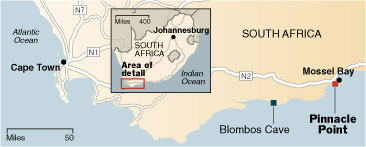
Source of map: online version of the NYT article quoted and cited below.
(p. A6) Previous research had indicated that human ancestors had for ages depended solely on terrestrial plants and animals. Both fossil and genetic data show that modern humans evolved 150,000 to 200,000 years ago, but archaeological evidence for the emergence of modern behavior in technology, creativity, symbolic thinking and lifestyles is sparse.
But six years ago, at Blombos Cave, near Pinnacle Point, archaeologists uncovered 77,000-year-old tools along with pigments and engraved stones suggesting symbolic behavior, a sign of early creativity. Now, at the Pinnacle Point cave site, the shellfish remains reveal another important innovation.
. . .
Forced to seek new sources of food, some of the people migrated to the shore in search of “famine food.” At Pinnacle Point, the discovery team reported, they feasted on a variety of marine life, brown mussels, giant periwinkles and whelks.
So on the southern shore of Africa, Dr. Marean said in a statement issued by Arizona State, a small population of cave-dwelling modern humans struggled and survived through the prevailing cold, eating shellfish and developing somewhat advanced technologies.
For the full story, see:
(Note: ellipses added.)
